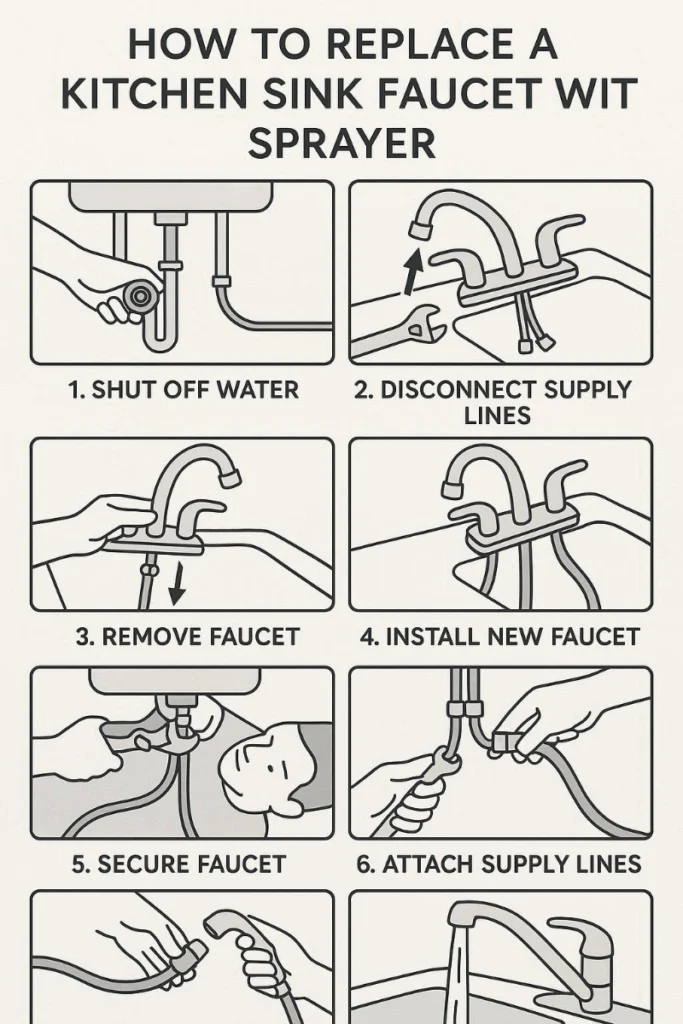Is your kitchen sink faucet looking a little worse for wear? Are you tired of dealing with constant leaks and poor water flow, or are you just looking to upgrade to a faucet with a sprayer for added convenience? Replacing your kitchen sink faucet with a sprayer is a relatively simple DIY project that can not only improve the functionality of your kitchen but also give it a fresh, modern look. In this Cleaning Guide for Home & Kitchen guide, we’ll walk you through everything you need to know to replace your faucet with sprayer, step by step.
Why You May Need to Replace Your Kitchen Sink Faucet
There are several reasons why you might want to replace your kitchen sink faucet:
- Leaking Faucet: Over time, faucets can start to leak due to wear and tear, causing water wastage and potential damage to your sink area.
- Outdated or Broken Faucet: If your faucet is outdated or malfunctioning, it may be time for an upgrade to something more efficient and stylish.
- Poor Water Flow: If your faucet no longer delivers a steady stream of water or has low water pressure, replacing it with a new faucet could help restore its full functionality.
- Upgrading to a Sprayer: A faucet with a sprayer makes cleaning your sink, dishes, and even washing fruits and vegetables much easier and more efficient.
Upgrading to a faucet with a sprayer gives you more flexibility in the kitchen and can improve both convenience and functionality. Whether you’re dealing with an old faucet that no longer works or you simply want to enhance your kitchen experience, replacing the faucet yourself is easier than you might think.
What to Expect from This Guide
In this blog, we’ll break down the entire process of replacing your kitchen sink faucet with a sprayer. You’ll get:
- Tools and materials you need to get started
- A step-by-step guide on how to remove the old faucet and install a new one
- Troubleshooting tips to help you fix any issues that arise
- Preventative maintenance advice to ensure your new faucet stays in great condition for years to come
By the end of this guide, you’ll feel confident tackling this DIY project yourself. So, let’s get started!
Tools and Materials You’ll Need for Replacing a Kitchen Sink Faucet with Sprayer
Before you dive into the replacement process, it’s important to gather all the necessary tools and materials. Having everything ready will make the installation process smoother and more efficient.
Basic Tools for Faucet Replacement
- Adjustable Wrench: This tool is essential for loosening and tightening the nuts on the water supply lines and faucet base.
- Basin Wrench: A basin wrench is specifically designed to reach and tighten mounting nuts that are located underneath the sink. It’s crucial for working in tight spaces.
- Screwdrivers (Flathead and Phillips): You’ll need these to remove any screws that may be holding your faucet in place or to attach the new faucet.
- Pipe Tape (Plumber’s Tape): This tape is used on threaded connections to prevent leaks by creating a secure seal between the parts.
- Plumber’s Putty: Plumber’s putty is optional but helpful for sealing the base of the faucet and preventing leaks.
Faucet and Sprayer Kit
- New Faucet with Sprayer: Ensure you purchase a faucet that comes with a sprayer (or purchase the sprayer separately if your faucet doesn’t include one). Double-check that the faucet is compatible with your sink.
- Mounting Hardware: This will include the nuts, washers, and mounting ring needed to secure the faucet to your sink.
- Water Supply Lines: If your new faucet does not come with new water supply lines, make sure to have those on hand. These should match the size of your water connections.
- Optional: Faucet Deck Plate: If you’re replacing a single-hole faucet with a multi-hole model, a deck plate may be necessary to cover the extra holes.
Preparing Your Sink and Workspace
Before you get started, make sure your workspace is ready. You’ll need to turn off the water supply and clear the sink area to create space for the new faucet installation.
Turn Off the Water Supply
The first step is to turn off the water supply to your kitchen sink. Locate the hot and cold water supply valves under your sink. Turn both valves clockwise to stop the water flow.
Once the water is off, test the faucet to ensure there is no running water. Place a towel or bucket under the water supply lines to catch any remaining water when disconnecting the lines.
Clear the Sink Area
Remove any dishes, sponges, or items from the sink to make sure there’s enough room to work. It’s also a good idea to place a towel or a bucket under the faucet area to catch any water that might spill during the replacement process.
Removing the Old Kitchen Sink Faucet
Now that your workspace is prepared, it’s time to remove the old faucet. Follow these steps to carefully disconnect the old faucet and get ready for the new one.
Loosen and Disconnect the Water Supply Lines
Use an adjustable wrench to loosen the connections on the hot and cold water supply lines. Be gentle, as over-tightening could cause the lines to break. Once the connections are loose, remove the water supply lines from the faucet.
Detach the Faucet from the Sink
Next, locate the mounting nuts securing the faucet to the sink. Use a basin wrench to reach and unscrew the nuts. These nuts are often tight and difficult to reach, which is why the basin wrench is so helpful. Once the mounting nuts are removed, lift the old faucet off the sink.
Clean the Sink Area
After removing the faucet, you’ll likely have some old plumber’s putty or sealant around the faucet base. Use a putty knife or cloth to remove any remaining residue. Make sure the area around the sink is clean and dry before installing the new faucet.
Installing the New Kitchen Sink Faucet with Sprayer
It’s time to install your new faucet! This is the fun part, and if you follow the steps carefully, it should go smoothly.
Attach the Faucet Base to the Sink
Start by positioning the new faucet over the mounting holes on the sink. Secure the faucet base with the mounting nuts provided in the kit. Tighten the nuts using a basin wrench, ensuring the faucet is stable and securely attached.
Install the Sprayer Hose and Mount
Next, attach the sprayer hose to the faucet base according to the manufacturer’s instructions. Some sprayers have a quick-connect feature, while others may require you to tighten the hose with an adjustable wrench. Once the hose is connected, install the sprayer holder onto the sink deck or countertop. The sprayer holder keeps the sprayer within easy reach when you need it.
Connect the Water Supply Lines
Now, connect the hot and cold water supply lines to the faucet. Use plumber’s tape on the threads of the faucet’s water inlet connections to prevent leaks. Tighten the connections with an adjustable wrench, but avoid over-tightening, as this could damage the threads or cause leaks.
Sealing and Testing the New Faucet
Once everything is installed, it’s time to test the faucet and make sure there are no leaks.
Apply Plumber’s Putty (if needed)
If your faucet requires sealing, apply a small amount of plumber’s putty around the base of the faucet. Carefully position the faucet and press it down to ensure it seals correctly.
Turn On the Water Supply
Slowly open the water supply valves and check for any leaks around the faucet and water connections. Turn on both the faucet and sprayer to ensure they’re both working properly. If you notice any issues, you may need to tighten a connection or apply more plumber’s tape.
Check for Leaks
Inspect the faucet base, water supply connections, and sprayer hose for leaks. Tighten any loose connections and re-test the faucet.
Troubleshooting Common Issues After Installing the Faucet
If you run into any issues after installing your new faucet, don’t worry! Here are some common problems and how to fix them.
Low Water Pressure
If your faucet is providing low water pressure, it may be due to a clogged aerator or sediment build-up inside the faucet. Remove the aerator and clean it by soaking it in vinegar. If that doesn’t solve the problem, inspect the water supply lines for blockages.
Leaks Around the Faucet
Leaks can occur at various points, including the supply line connections, faucet base, and sprayer hose. If you notice a leak, check the tightness of the connections, apply more plumber’s tape, or reseal the base with fresh plumber’s putty.
Sprayer Not Working
If the sprayer isn’t functioning, make sure the hose is properly connected and there are no kinks or blockages. If everything looks good, check the diverter valve to ensure it’s not clogged or malfunctioning.
Preventative Tips to Keep Your Kitchen Sink Faucet in Good Condition
Now that your new faucet is installed, it’s important to maintain it to keep it in good condition for years to come.
Regularly Clean the Faucet and Sprayer
To avoid mineral build-up and ensure proper water flow, clean the faucet aerator and sprayer nozzle regularly. Soak the aerator in a vinegar solution to remove hard water deposits.
Avoid Using Harsh Chemicals
Use mild cleaners for your faucet to avoid damaging its finish. Harsh chemicals can cause corrosion and rust, so stick to gentle, non-abrasive cleaners.
Maintain the Water Supply Lines
Periodically check the water supply lines for any signs of wear or damage. If you notice cracks or leaks, replace the supply lines promptly to avoid further issues.
Conclusion
Replacing your kitchen sink faucet with a sprayer is a great way to enhance the functionality and look of your kitchen. By following this simple, step-by-step guide, you can easily remove your old faucet and install a new one yourself. Remember to take your time, double-check your connections, and always test for leaks before finishing the job.
Upgrading to a new faucet with sprayer not only improves your kitchen’s aesthetics but also provides added convenience for daily tasks. So grab your tools and get started on this DIY project—you’ve got this!
FAQ
How long does it take to replace a kitchen sink faucet with sprayer?
Typically, it should take 1-2 hours to replace a faucet, depending on your experience and the complexity of your setup.
Do I need to remove the old faucet entirely before installing the new one?
Yes, the old faucet needs to be removed completely to ensure the new one fits properly and functions well.
Can I install a sprayer on any kitchen faucet?
Not all faucets are sprayer-compatible, but there are attachment kits available for faucets that don’t come with sprayers.
How do I know if my faucet needs replacing?
Signs like leaks, low water pressure, or poor functionality are indicators that it’s time to replace your faucet.
Can I replace the faucet without professional help?
Yes, replacing a faucet is a DIY-friendly task that most homeowners can complete with the right tools and guidance.
Call to Action
Ready to replace your kitchen sink faucet with a sprayer? Use this guide to take on the project yourself confidently. If you run into any issues or need more tips, check out our other plumbing maintenance articles for additional advice! Happy DIY-ing!

